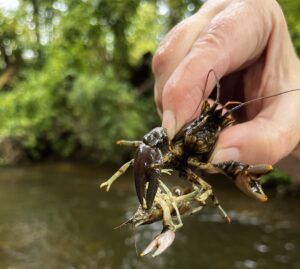
Meet Our Grad Student Scholars is a series from Illinois-Indiana Sea Grant (IISG) celebrating the students and research funded by our scholars program. To learn more about our faculty and graduate student funding opportunities, visit Fellowships & Scholarships.
Kathryn Mudica is a Ph.D. candidate at Indiana State University. Her dissertation focus has been biogeochemical research in trace metal pollutants in freshwater using biotic indicators. As a water-ecosystem scientist, she has spent much of her time in the field, understanding aquatic systems and river ecology. This work has taken her to more than 50 of Indiana’s creeks and streams collecting crayfish and other biotic indicators. She has also traversed the 500 miles of the Wabash River, researching water quality in this vital watershed. Her expected graduation date will be the summer of 2024, after which she hopes to continue to spend her days wading in Indiana’s rivers and creeks and researching water quality.
Streams and rivers are among the most valuable resources humans utilize, but a freshwater system is only as healthy as the organisms that rely on it. Freshwater systems are particularly vulnerable to the environmental persistence of biologically available mercury due to the methylation of elemental mercury. Anthropogenic activities such as coal combustion, mining, petrochemical production, and other industries have altered the pre-anthropogenic cycle of mercury, including mercury speciation. These activities have made mercury biologically available in unnatural concentrations. Once emitted, the biogeochemical cycle of mercury involves atmospheric transport, deposition to land and waterways, and revolatilization, continuing to accumulate despite reductions in emissions. Many coal-fired power plants in Indiana continue to release as much as 2,174 pounds per year, continuing to add mercury to the environment. While these power plants conform to federal regulations, Indiana as a state has not imposed state-specific regulations on the output of mercury to protect the state further. This is particularly troublesome as Indiana relies on coal for more than 50% of its energy production. It is home to 13 operational coal-fired power plants, ranking third in the nation.

West Branch Trail Creek, Waterford, Indiana. With a cobbled substrate and active riffes, Trail Creek is a great crayfish habitat.
Healthy aquatic ecosystems play a significant role in creating and supporting communities. Monitoring, maintaining, and improving healthy waterways can be challenging where historic industries pollute these systems with long-lasting contaminants. Major rivers and resources like Lake Michigan are monitored, but smaller creeks contribute to water quality while also being temporary repositories for pollutants. These creeks and streams can be difficult to monitor and assess for water quality due to limited stream flow and difficult accessibility. Unfortunately, these same water systems can play a significant role in the input of metals and other pollutants into our major waterways. An economical and reliable approach to determining water quality in these areas would be to identify reliable sentinel species that are endemic, easily identified, and respond in a quantifiably significant way to metals in the environment. Similar approaches using macroinvertebrate assemblages have been used successfully in citizen scientist programs and bioblitzes. However, these indices can be complicated, seasonal, and difficult to assess without identification bias. As an alternative, this research proposes, a one-organism approach as a biotic indicator, by documenting mercury in crayfish species and their environment to determine a species-specific response to mercury.
Often interacting as suspension feeders, crayfish interact with the water column continuously through brachial respiration as well as external filtering using their antennae to glean particles from the water. More aggressive crayfish species likely act as predators, moving out of safety zones to actively hunt for more substantial protein sources. These strategies vary not only by the creek but also by species. Too often, generalized responses of organisms such as order or family are used as indicators to assess the impact of mercury. While these general assessments are convenient, they do not take into consideration the varied life strategies that take place on a species level.
Indiana has a diverse range of crayfish species. Historic survey data revealed 22 known species exist throughout the state, with 11 of these belonging to the genus Faxonius. This diversity makes Indiana an excellent study area to determine species’ response to mercury in Indiana creeks.

Faxonius rusticus (Rusty crayfish) are an aggressive invasive species in the Little Calumet-Galien Watershed, displacing native crayfish.
For Kathryn’s project, crayfish samples, water samples, and sediment samples were collected in several creeks in the Little Calumet-Galien Watershed representing a variety of environmental exposures. She hypothesized that crayfish’s environmental interactions as omnivores and biotic engineers place them in a unique environmental niche, making them a reliable sentinel species. By testing and comparing the bioaccumulation of metals in crayfish tissue, water, and sediments, to dominant species, average crayfish size, and population density, we can reliably predict creek health for metals based on the specific crayfish species found. Along with the determination of crayfish as a sentinel species, this study method could be used to create community outreach and citizen science projects in alignment with the IISG Mission of creating an environmentally literate population. This research project will attempt to broaden our understanding of metal transport in aquatic ecosystems.
Illinois-Indiana Sea Grant is a partnership between NOAA, University of Illinois Extension, and Purdue University Forestry and Natural Resources, bringing science together with communities for solutions that work. Sea Grant is a network of 34 science, education and outreach programs located in every coastal and Great Lakes state, Lake Champlain, Puerto Rico and Guam.

